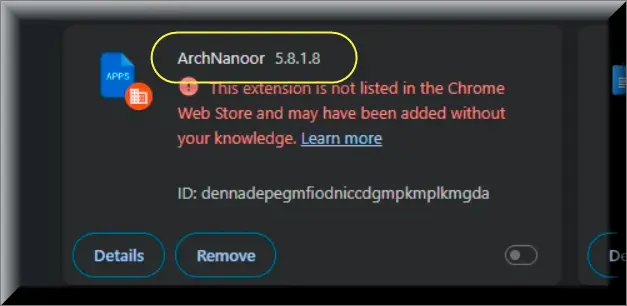What are the capabilities of ArchNanoor?
ArchNanoor is a browser hijacker, which basically is a type of software created to interfere with your web browsing settings. After installation, it changes your homepage or default search engine to one of its control, taking you away from your desired settings. In the case of this hijacker, it doesn’t stop just there. Not only does ArchNanoor alter the browser’s appearance, but it also sends ads straight to your search results or reroutes your searches entirely. The end of the story is that it aims to increase traffic to certain websites that are earning a revenue for the developers. In addition to the obvious interference in your online experience, ArchNanoor also keeps track of what websites you visit, what you inquire into the bar, and what you click on. Such information can also be used to create a profile for your interests, but sometimes this data is sold to third parties. This increases the potential dangers of your search information-use beyond direct targeted advertising.

In what ways can I get infected with the ArchNanoor virus?
Infections with the ArchNanoor virus most commonly happen after installing software from suspicious or unknown sources. Furthermore, such software is frequently included in the installation files of various free applications, or phony software updates. If you choose the ‘quick’ or ‘recommended’ installation settings, you may unknowingly agree to install the hijacker alongside the intended program. Following that, clicking on questionable links or advertisements could result in an automated downloading and installation of such undesirable software.
What are the warning signs of ArchNanoor?
There are a few obvious signs that you have installed ArchNanoor, Chromstera, Universal Browser or UniversalUpdater on your device. The homepage of your browser may change inexplicably, or a new toolbar may appear on your computer without your permission. You may be frequently redirected to ArchNanoor.com or any other website, and you will not be able to stop it. You may also see way too many windows popping up during your web browsing or different types of ads. For example, you may see ads or notifications about events on a website that does not contain ads or aggressive statements under normal circumstances.
Can clicking on ArchNanoor pop-ups be dangerous?
It is indeed very dangerous to click on these ArchNanoor pop-ups you see all over your screen. The websites you are re-directed to may end up loading your computer not only with more dangerous malware, but also try to steal from you some personal or identifiable information via phishing attacks. Even in seemingly safe situations, more aggressive adware can be installed on your computer if you happen to click on some misleading advertisement. Therefore, our general advice is to stay away from the ArchNanoor pop-ups and use the instructions on this page to remove the browser hijacker that is generating them.
Is ArchNanoor on Chrome making my browser slow?
With ArchNanoor on Chrome, browsing will also be very slow, aside from all the other types of ads and pop-ups disturbance. The bottom line is that the hijacker loads ads by exploiting the resources of your system and runs unnecessary processes in the background. As a result, this consumes a certain amount of performance power from the system, which makes the browser load the page for a long time and work sluggishly in general.
How can I prevent my browser to download ArchNanoor extension?
To finally not download ArchNanoor extension anymore, you need to uninstall all browser add-ons or toolbars that did not get your explicit permission. In addition, resetting browser settings will help eliminate the remaining changes automatically. You can also install an antivirus program. With its help, there is a high probability that if the system gets infected with something potentially unwanted or dangerous, that you would be the first to know. As antivirus silently scans the full system and can remove programs like ArchNanoor extension before it causes a real headache.
Remove ArchNanoor Virus
To try and remove ArchNanoor quickly you can try this:
- Go to your browser’s settings and select More Tools (or Add-ons, depending on your browser).
- Then click on the Extensions tab.
- Look for the ArchNanoor extension (as well as any other unfamiliar ones).
- Remove ArchNanoor by clicking on the Trash Bin icon next to its name.
- Confirm and get rid of ArchNanoor and any other suspicious items.
If this does not work as described please follow our more detailed ArchNanoor removal guide below.
If you have a Windows virus, continue with the guide below.
If you have a Mac virus, please use our How to remove Ads on Mac guide.
If you have an Android virus, please use our Android Malware Removal guide.
If you have an iPhone virus, please use our iPhone Virus Removal guide.
Some of the steps may require you to exit the page. Bookmark it for later reference.
Next, Reboot in Safe Mode (use this guide if you don’t know how to do it).
 Uninstall the ArchNanoor app and kill its processes
Uninstall the ArchNanoor app and kill its processes
The first thing you must try to do is look for any sketchy installs on your computer and uninstall anything you think may come from ArchNanoor. After that, you’ll also need to get rid of any processes that may be related to the unwanted app by searching for them in the Task Manager.
Note that sometimes an app, especially a rogue one, may ask you to install something else or keep some of its data (such as settings files) on your PC – never agree to that when trying to delete a potentially rogue software. You need to make sure that everything is removed from your PC to get rid of the malware. Also, if you aren’t allowed to go through with the uninstallation, proceed with the guide, and try again after you’ve completed everything else.
- Uninstalling the rogue app
- Killing any rogue processes
Type Apps & Features in the Start Menu, open the first result, sort the list of apps by date, and look for suspicious recently installed entries.
Click on anything you think could be linked to ArchNanoor, then select uninstall, and follow the prompts to delete the app.

Press Ctrl + Shift + Esc, click More Details (if it’s not already clicked), and look for suspicious entries that may be linked to ArchNanoor.
If you come across a questionable process, right-click it, click Open File Location, scan the files with the free online malware scanner shown below, and then delete anything that gets flagged as a threat.


After that, if the rogue process is still visible in the Task Manager, right-click it again and select End Process.
 Undo ArchNanoor changes made to different system settings
Undo ArchNanoor changes made to different system settings
It’s possible that ArchNanoor has affected various parts of your system, making changes to their settings. This can enable the malware to stay on the computer or automatically reinstall itself after you’ve seemingly deleted it. Therefore, you need to check the following elements by going to the Start Menu, searching for specific system elements that may have been affected, and pressing Enter to open them and see if anything has been changed there without your approval. Then you must undo any unwanted changes made to these settings in the way shown below:
- DNS
- Hosts
- Startup
- Task
Scheduler - Services
- Registry
Type in Start Menu: View network connections
Right-click on your primary network, go to Properties, and do this:

Type in Start Menu: C:\Windows\System32\drivers\etc\hosts

Type in the Start Menu: Startup apps

Type in the Start Menu: Task Scheduler

Type in the Start Menu: Services

Type in the Start Menu: Registry Editor
Press Ctrl + F to open the search window

 Remove ArchNanoor from your browsers
Remove ArchNanoor from your browsers
- Delete ArchNanoor from Chrome
- Delete ArchNanoor from Firefox
- Delete ArchNanoor from Edge
- Go to the Chrome menu > More tools > Extensions, and toggle off and Remove any unwanted extensions.
- Next, in the Chrome Menu, go to Settings > Privacy and security > Clear browsing data > Advanced. Tick everything except Passwords and click OK.
- Go to Privacy & Security > Site Settings > Notifications and delete any suspicious sites that are allowed to send you notifications. Do the same in Site Settings > Pop-ups and redirects.
- Go to Appearance and if there’s a suspicious URL in the Custom web address field, delete it.
- irefox menu, go to Add-ons and themes > Extensions, toggle off any questionable extensions, click their three-dots menu, and click Remove.
- Open Settings from the Firefox menu, go to Privacy & Security > Clear Data, and click Clear.
- Scroll down to Permissions, click Settings on each permission, and delete from it any questionable sites.
- Go to the Home tab, see if there’s a suspicious URL in the Homepage and new windows field, and delete it.
- Open the browser menu, go to Extensions, click Manage Extensions, and Disable and Remove any rogue items.
- From the browser menu, click Settings > Privacy, searches, and services > Choose what to clear, check all boxes except Passwords, and click Clear now.
- Go to the Cookies and site permissions tab, check each type of permission for permitted rogue sites, and delete them.
- Open the Start, home, and new tabs section, and if there’s a rogue URL under Home button, delete it.


Leave a Comment